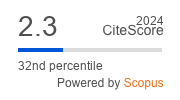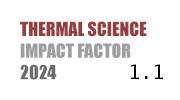ABSTRACT
With growing environmental concerns, natural ester transformers are widely used due to their excellent properties and good biodegradability. However, their thermal characteristics under extreme ambient temperatures remain unclear, limiting their widespread adoption. Herein, a Numerical simulation model is used to simulate and evaluate the temperature distribution, hot-spot temperature and thermal stability of natural ester transformers. A mineral oil transformer is used for comparison. The results indicate that the hot-spot temperature of the natural ester transformer is always higher than that of the mineral oil transformer under the same heat dissipation structure. With the increase of ambient temperature, the variation trends of their hot-spot temperatures initially decrease and then increase, and the minimum hot-spot temperatures appear around the -10°C ambient temperature. The hot-spot temperature increases when ambient temperature continues to go up. However, the hot-spot temperature of the natural ester transformer remains within the limits specified by the IEEE standard under the extremely high ambient temperature (52.2°C). In contrast, the mineral oil transformer exhibits localized overheating in the windings, in which the overheated zone accounts for approximately 50% of the total winding. Actually, when the ambient temperature exceeds 45°C, the hot-spot temperature of the mineral oil transformer reaches its limit, while that of the natural ester transformer remains within its safe limit. The results demonstrate the superiority of natural ester transformers when used at high ambient temperatures, while also providing a reference for the design and application of natural ester transformers under extreme ambient temperatures.
KEYWORDS
PAPER SUBMITTED: 2025-04-26
PAPER REVISED: 2025-05-21
PAPER ACCEPTED: 2025-05-29
PUBLISHED ONLINE: 2025-07-05
- Zhang, Y. Y., et al., Bubble formation and motion characteristics in the transformer oil-paper insulation system under the extremely inhomogeneous electric field, IEEE Transations on Dielectrics Electrical Insulation, 30(2023), 4, pp. 1752-1759
- Lyutikova, M. N., et al., Mixed Insulating Liquids With Mineral Oil for High-Voltage Transformer Applications: A Review, IEEE Transations on Dielectrics Electrical Insulation, 29(2022), 2, pp. 454-461
- Reffas, A., et al., Comparison of breakdown voltage of vegetable olive with mineral oil, natural and synthetic ester liquids under DC voltage, IEEE Transations on Dielectrics Electrical Insulation, 27(2020), 5, pp. 1691-1697
- Wang, Y. W., et al., Insulation design analysis for natural ester oil power transformers, Proceedings, 2024 IEEE 14th International Conference on the Properties and Applications of Dielectric Materials (ICPADM), Phuket, Thailand, 2024, pp. 291-294
- Seddik, M. S., et al., Thermal analysis of power transformer using 2d and 3d finite element method, Energies, 17(2024), 13, pp.3203
- Liao, C. B., et al., 3-D Coupled Electromagnetic-Fluid-Thermal Analysis of Oil-Immersed Triangular Wound Core Transformer, IEEE Transactions on Magnetics, 50(2014), 11, pp. 1-4
- IEEE Guide for Loading Mineral-Oil-Immersed Transformers and Step-Voltage Regulators, IEEE Std C57.91, 2011
- Power Transformers-Part 7:Loading Guide for Mineral-Oil-Immersed Power Transformers, IEC 60076-7, 2018
- Melka, B., et al., Effective cooling of a distribution transformer using biodegradable oils at different climate conditions, IEEE Transations on Dielectrics Electrical Insulation, 30(2023), 4, pp. 1557-1565
- Deng, Y.Q., et al., A Method for Hot Spot Temperature Prediction of a 10 kV Oil-Immersed Transformer, IEEE Access, 7(2019), pp. 107380-107388
- Feng, X.Y., et al., Magnetic-Thermal-Flow Field Coupling Simulation of Oil-Immersed Transformer, IEEE Access, 12(2024), pp. 65462-65470
- Chereches, N.-C., et al., Numerical study of cooling solutions inside a power transformer, Energy Procedia, 112(2017), pp. 314-321
- Zhang,X., et al.,Temperature distribution evolution of transformer windings thermal defect and its identification method(in Chinese), High Voltage Engineering, 50(2024), 4, pp. 1548-1559
- Liu, X.T., Detailed Explanation of Engineering Examples for Finite Element Analysis Using ANSYS Workbench(in Chinese), Railway Publishing House, Beijing, China, 2017
- Cargill, FR3® fluid behavior in cold temperature environments, www.cargill.com
- Cargill, Cold start recommendations for FR3® fluid filled transformers,.www.cargill.com
- Mehta, D. M., et al., A review on critical evaluation of natural ester vis-a-vis mineral oil insulating liquid for use in transformers: Part 1, IEEE Transations on Dielectrics Electrical Insulation, 23(2016), 2, pp. 873-880
- Bayrak, E., et al., Numerical study on mechanisms underlying the heat transfer enhancement of upward supercritical CO2 flow at low Reynolds numbers near the pseudo-critical region through a microtube, International Communications in Heat and Mass Transfer, 165 (2025)
- Ma, B., et al., A study on the optimization of cooling performance for oil-immersed transformers in high temperature environments utilizing response surface methodology, Case Studies in Thermal Engineering, 63(2024)
- Torriano, F., et al., Numerical and experimental thermofluidic investigation of different disc-type power transformer winding arrangements, International Journal of Heat and Fluid Flow, 69(2018)
- Dorella, J. J., et al., Enhancing heat transfer in power transformer radiators via thermo-fluid dynamic analysis with periodic thermal boundary conditions, International Journal of Heat and Mass Transfer, 222(2024)
- IEEE Standard for Liquid-Immersed Transformers Designed to Operate at Temperatures Above Conventional Limits Using High- Temperature Insulation Systems, IEEE Std C57.154, 202
- IEEE Standard for Test Procedure for Thermal Evaluation of Insulation Systems for Liquid-Immersed Distribution, Power, and Regulating Transformers, IEEE Std C57.100, 2022
- IEEE Standard for General Requirements for Liquid-Immersed Distribution, Power, and Regulating Transformers, IEEE Std C57.12.00, 2021
- IEEE Guide for the Application of High-Temperature Insulation Materials in Liquid-Immersed Distribution, Power, and Regulating Transformers, IEEE Std 1276, 2020
- Wang, Y. M., et al., Production pattern of furfural in esters-immersed paper and aging evaluation methods, IEEE Transations on Dielectrics Electrical Insulation, 2024
- Mo, S., et al., Effect of bubble flow on partial discharge under non-uniform AC electric fields in FC-72, IEEE Transations on Dielectrics Electrical Insulation, 27(2020), 4, pp. 1059-1067

